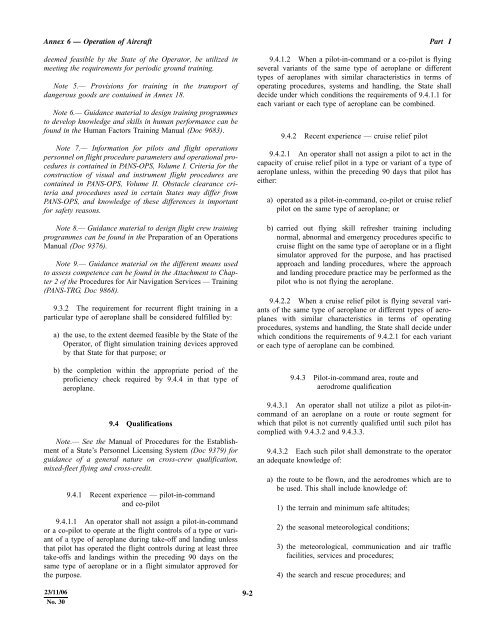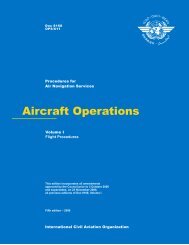Operation of Aircraft
Annex 6, Part I
Annex 6, Part I
- No tags were found...
You also want an ePaper? Increase the reach of your titles
YUMPU automatically turns print PDFs into web optimized ePapers that Google loves.
Annex 6 — <strong>Operation</strong> <strong>of</strong> <strong>Aircraft</strong><br />
deemed feasible by the State <strong>of</strong> the Operator, be utilized in<br />
meeting the requirements for periodic ground training.<br />
Note 5.— Provisions for training in the transport <strong>of</strong><br />
dangerous goods are contained in Annex 18.<br />
Note 6.— Guidance material to design training programmes<br />
to develop knowledge and skills in human performance can be<br />
found in the Human Factors Training Manual (Doc 9683).<br />
Note 7.— Information for pilots and flight operations<br />
personnel on flight procedure parameters and operational procedures<br />
is contained in PANS-OPS, Volume I. Criteria for the<br />
construction <strong>of</strong> visual and instrument flight procedures are<br />
contained in PANS-OPS, Volume II. Obstacle clearance criteria<br />
and procedures used in certain States may differ from<br />
PANS-OPS, and knowledge <strong>of</strong> these differences is important<br />
for safety reasons.<br />
Note 8.— Guidance material to design flight crew training<br />
programmes can be found in the Preparation <strong>of</strong> an <strong>Operation</strong>s<br />
Manual (Doc 9376).<br />
Note 9.— Guidance material on the different means used<br />
to assess competence can be found in the Attachment to Chapter<br />
2 <strong>of</strong> the Procedures for Air Navigation Services — Training<br />
(PANS-TRG, Doc 9868).<br />
9.3.2 The requirement for recurrent flight training in a<br />
particular type <strong>of</strong> aeroplane shall be considered fulfilled by:<br />
a) the use, to the extent deemed feasible by the State <strong>of</strong> the<br />
Operator, <strong>of</strong> flight simulation training devices approved<br />
by that State for that purpose; or<br />
b) the completion within the appropriate period <strong>of</strong> the<br />
pr<strong>of</strong>iciency check required by 9.4.4 in that type <strong>of</strong><br />
aeroplane.<br />
9.4 Qualifications<br />
Note.— See the Manual <strong>of</strong> Procedures for the Establishment<br />
<strong>of</strong> a State’s Personnel Licensing System (Doc 9379) for<br />
guidance <strong>of</strong> a general nature on cross-crew qualification,<br />
mixed-fleet flying and cross-credit.<br />
9.4.1 Recent experience — pilot-in-command<br />
and co-pilot<br />
9.4.1.1 An operator shall not assign a pilot-in-command<br />
or a co-pilot to operate at the flight controls <strong>of</strong> a type or variant<br />
<strong>of</strong> a type <strong>of</strong> aeroplane during take-<strong>of</strong>f and landing unless<br />
that pilot has operated the flight controls during at least three<br />
take-<strong>of</strong>fs and landings within the preceding 90 days on the<br />
same type <strong>of</strong> aeroplane or in a flight simulator approved for<br />
the purpose.<br />
Part I<br />
9.4.1.2 When a pilot-in-command or a co-pilot is flying<br />
several variants <strong>of</strong> the same type <strong>of</strong> aeroplane or different<br />
types <strong>of</strong> aeroplanes with similar characteristics in terms <strong>of</strong><br />
operating procedures, systems and handling, the State shall<br />
decide under which conditions the requirements <strong>of</strong> 9.4.1.1 for<br />
each variant or each type <strong>of</strong> aeroplane can be combined.<br />
9.4.2 Recent experience — cruise relief pilot<br />
9.4.2.1 An operator shall not assign a pilot to act in the<br />
capacity <strong>of</strong> cruise relief pilot in a type or variant <strong>of</strong> a type <strong>of</strong><br />
aeroplane unless, within the preceding 90 days that pilot has<br />
either:<br />
a) operated as a pilot-in-command, co-pilot or cruise relief<br />
pilot on the same type <strong>of</strong> aeroplane; or<br />
b) carried out flying skill refresher training including<br />
normal, abnormal and emergency procedures specific to<br />
cruise flight on the same type <strong>of</strong> aeroplane or in a flight<br />
simulator approved for the purpose, and has practised<br />
approach and landing procedures, where the approach<br />
and landing procedure practice may be performed as the<br />
pilot who is not flying the aeroplane.<br />
9.4.2.2 When a cruise relief pilot is flying several variants<br />
<strong>of</strong> the same type <strong>of</strong> aeroplane or different types <strong>of</strong> aeroplanes<br />
with similar characteristics in terms <strong>of</strong> operating<br />
procedures, systems and handling, the State shall decide under<br />
which conditions the requirements <strong>of</strong> 9.4.2.1 for each variant<br />
or each type <strong>of</strong> aeroplane can be combined.<br />
9.4.3 Pilot-in-command area, route and<br />
aerodrome qualification<br />
9.4.3.1 An operator shall not utilize a pilot as pilot-incommand<br />
<strong>of</strong> an aeroplane on a route or route segment for<br />
which that pilot is not currently qualified until such pilot has<br />
complied with 9.4.3.2 and 9.4.3.3.<br />
9.4.3.2 Each such pilot shall demonstrate to the operator<br />
an adequate knowledge <strong>of</strong>:<br />
a) the route to be flown, and the aerodromes which are to<br />
be used. This shall include knowledge <strong>of</strong>:<br />
1) the terrain and minimum safe altitudes;<br />
2) the seasonal meteorological conditions;<br />
3) the meteorological, communication and air traffic<br />
facilities, services and procedures;<br />
4) the search and rescue procedures; and<br />
1/11/01 23/11/06<br />
9-2<br />
No. 30












